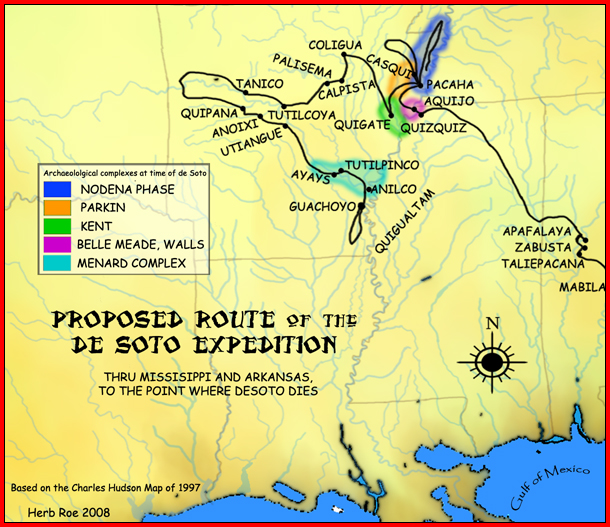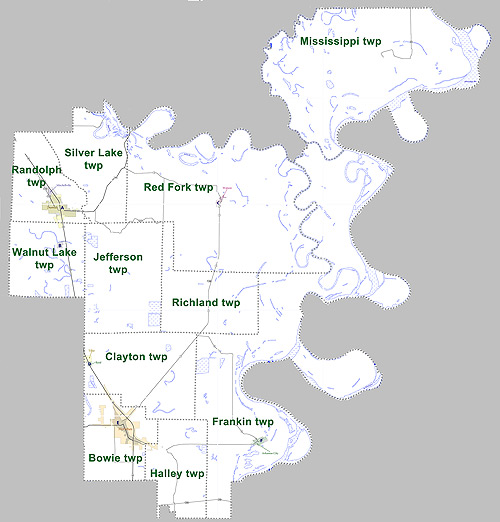|
Menard–Hodges Site
The Menard–Hodges site ( 3AR4) (also known as Menard-Hodges Mounds and Osotouy), is an archaeological site in Arkansas County, Arkansas. It includes two large platform mounds as well as several house mounds. It is the type site for the Menard phase, a protohistoric Mississippian culture group. The Menard Mound was named for Frank Menard, on whose farm the mound was discovered. Description The site is considered as a possible candidate for the Province of Anilco encountered by the Hernando de Soto Entrada in 1540. It was contemporaneous with the Parkin site, believed by many archaeologists to be the location of the province of Casqui, and the Nodena site, believed by many archaeologists to be the location of the province of Pacaha. The site is also considered to be the location of the protohistoric Quapaw village of ''Osotouy'' (or ''Ossoteoue'') first encountered by French explorers in the late 17th century. The Quapaw at the time had four villages, Kappa, Ossoteoue, ... [...More Info...] [...Related Items...] OR: [Wikipedia] [Google] [Baidu] |
Nady, Arkansas
Nady is an unincorporated community in Arkansas County Arkansas County is a county located in the U.S. state of Arkansas. As of the 2010 census, the population was 19,019. Located in the Arkansas Delta, the county has two county seats, DeWitt and Stuttgart. The first of the state's 75 presen ..., Arkansas, United States. It is the location of a National Historic Landmark, the Menard–Hodges site. The environs of Nady, at the southern tip of the Little Prairie, are in the portion of Arkansas that saw the earliest European settlement in what is now the state of Arkansas, including Tonty’s 1686 post. The Menard-Hodges archeological site, about one-half mile southwest of Wallace-Menard-Coose Cemetery, along with the adjacent Wallace Bottom archeological site, appear to be the locations of the late 1600s Quapaw village of Osotouy, Tonty’s 1686 Post, and the early to mid-1700s French Arkansas Post. The Geographic Names Information System (GNIS) provides the location ... [...More Info...] [...Related Items...] OR: [Wikipedia] [Google] [Baidu] |
Desha County, Arkansas
Desha County ( ) is a county located in the southeast part of the U.S. state of Arkansas, with its eastern border the Mississippi River. At the 2010 census, the population was 13,008. It ranks 56th of Arkansas's 75 counties in terms of population. The county seat is Arkansas City. Located in the Arkansas Delta, Desha County's rivers and fertile soils became prosperous for planters under the cotton-based economy of plantation agriculture in the antebellum years and late 19th century. Still largely rural, it has suffered population losses and economic decline since the mid-20th century. But following widespread farm mechanization, Desha County underwent a demographic and economic transformation. Farm workers left the area because of the lack of work, and there was a decline in population. Farm holdings have been consolidated into industrial style farms and the economy cannot support much activity. In the 21st century, the county is seeking to reverse population and economic los ... [...More Info...] [...Related Items...] OR: [Wikipedia] [Google] [Baidu] |
Archaeological Type Sites
Archaeology or archeology is the scientific study of human activity through the recovery and analysis of material culture. The archaeological record consists of artifacts, architecture, biofacts or ecofacts, sites, and cultural landscapes. Archaeology can be considered both a social science and a branch of the humanities. It is usually considered an independent academic discipline, but may also be classified as part of anthropology (in North America – the four-field approach), history or geography. Archaeologists study human prehistory and history, from the development of the first stone tools at Lomekwi in East Africa 3.3 million years ago up until recent decades. Archaeology is distinct from palaeontology, which is the study of fossil remains. Archaeology is particularly important for learning about prehistoric societies, for which, by definition, there are no written records. Prehistory includes over 99% of the human past, from the Paleolithic until the advent ... [...More Info...] [...Related Items...] OR: [Wikipedia] [Google] [Baidu] |
National Register Of Historic Places Listings In Arkansas County, Arkansas
__NOTOC__ This is a list of the National Register of Historic Places listings in Arkansas County, Arkansas. This is intended to be a complete list of the properties and districts on the National Register of Historic Places in Arkansas County, Arkansas, United States. The locations of National Register properties and districts for which the latitude and longitude coordinates are included below, may be seen in a map. There are 26 properties and districts listed on the National Register in the county, including 2 National Historic Landmarks. Current listings See also *List of National Historic Landmarks in Arkansas *National Register of Historic Places listings in Arkansas This is a list of properties and historic districts in Arkansas that are listed on the National Register of Historic Places. There are more than 2,600 listings in the state, including at least 8 listings in each of Arkansas's 75 counties. Num ... References {{Arkansas ... [...More Info...] [...Related Items...] OR: [Wikipedia] [Google] [Baidu] |
List Of National Historic Landmarks In Arkansas
The National Historic Landmarks in Arkansas represent Arkansas's history from the Louisiana Purchase through the Civil War and the Civil Rights Movement. It contains the landmarks designated by the U.S. Federal Government for the U.S. state of Arkansas. There are 17 National Historic Landmarks (NHLs) in Arkansas. Another NHL was formerly listed in the state but was moved to Oakland, California. This page includes a list of National Park Service-administered historic areas in Arkansas. National Historic Landmarks This is a complete list of the 17 National Historic Landmarks in Arkansas. Historic areas administered by the National Park Service National Historic Sites, National Historical Parks, National Monuments, and certain other areas listed in the National Park system are historic landmarks of national importance that are highly protected already, often before the inauguration of the NHL program in 1960, and are then often not also named NHLs ''per se ... [...More Info...] [...Related Items...] OR: [Wikipedia] [Google] [Baidu] |
History Of The Tunica People
The Tunica people are a group of linguistically and culturally related Native American tribes in the Mississippi River Valley, which include the Tunica (also spelled Tonica, Tonnica, and Thonnica); the Yazoo; the Koroa (Akoroa, Courouais); and possibly the Tioux. They first encountered Europeans in 1541 – members of the Hernando de Soto expedition. The Tunica language is an isolate. Over the next centuries, under pressure from hostile neighbors, the Tunica migrated south from the Central Mississippi Valley to the Lower Mississippi Valley. Eventually they moved westward and settled around present-day Marksville, Louisiana. Since the early 19th century, they have intermarried with the Biloxi tribe, an unrelated Siouan-speaking people from the vicinity of Biloxi, Mississippi and shared land. Remnant peoples from other small tribes also merged with them. In 1981 they were federally recognized and now call themselves the Tunica-Biloxi Indian Tribe; they have a reservation in A ... [...More Info...] [...Related Items...] OR: [Wikipedia] [Google] [Baidu] |
List Of Sites And Peoples Visited By The Hernando De Soto Expedition
This is a list of sites and peoples visited by the Hernando de Soto Expedition in the years 1539–1543. In May 1539, de Soto left Havana, Cuba, with nine ships, over 620 men and 220 surviving horses and landed at Charlotte Harbor, Florida. This began his three-year odyssey through the Southeastern North American continent, from which de Soto and a large portion of his men would not return. They met many varied Native American groups, most of them bands and chiefdoms related to the widespread Mississippian culture. Only a few of these ancestral cultures survived into the seventeenth century, or their descendants combined as historic tribes known to later Europeans. Others have been recorded only in the written historical accounts of de Soto's expedition. Florida * Uzita * Mocoso * Urriparacoxi * Timucua * Ocale * Acuera * Potano * Alachua culture * Northern Utina * Yustaga * Uzachile * Anhaica * Apalachee * Narváez expedition's "Bay of Horses" Georgia The people ... [...More Info...] [...Related Items...] OR: [Wikipedia] [Google] [Baidu] |
Hodges House (Bismarck, Arkansas)
The Hodges House is a historic house on the east side of Arkansas Highway 7 south of the rural community of Bismarck, Arkansas. It is a distinctive single-story wood-frame house, with a projecting polygonal bay at one corner, and a porch that wraps around three sides of the house. The porch is supported by turned posts and has an elaborate Folk Victorian balustrade. The house was built in 1907 by Lee and Clara DeBray, and was sold to Thomas and Charlotte Hodges in 1925. Both of the Hodgeses were leading figures in the early development of archaeology in the state of Arkansas, amassing a collection of more than 50,000 artifacts, and occupying leadership positions in the Arkansas Archaeological Society. The Menard–Hodges site, now a National Historic Landmark, was purchased by Hodges in order to control research and preservation activities. The house was listed on the National Register of Historic Places in 1995. See also *National Register of Historic Places listings in Hot ... [...More Info...] [...Related Items...] OR: [Wikipedia] [Google] [Baidu] |
Arkansas Post National Memorial
The Arkansas Post (french: Poste de Arkansea) (Spanish: ''Puesto de Arkansas''), formally the Arkansas Post National Memorial, was the first European settlement in the Mississippi Alluvial Plain and present-day U.S. state of Arkansas. In 1686, Henri de Tonti established it on behalf of Louis XIV of France for the purpose of trading with the Quapaw Nation. The French, Spanish, and Americans, who acquired the territory in 1803 with the Louisiana Purchase, considered the site of strategic value. It was the capital of Arkansas from 1819 until 1821 when the territorial government relocated to Little Rock. During the fur trade years, Arkansas Post was protected by a series of fortifications. The forts and associated settlements were located at three known sites and possibly a fourth. Some of the historic structures have been lost as the waterfront has been subject to erosion and flooding. The land encompassing the second (and fourth) Arkansas Post site (Red Bluff) was designated a ... [...More Info...] [...Related Items...] OR: [Wikipedia] [Google] [Baidu] |
National Park Service
The National Park Service (NPS) is an List of federal agencies in the United States, agency of the Federal government of the United States, United States federal government within the United States Department of the Interior, U.S. Department of the Interior that manages all List of areas in the United States National Park System, national parks, most National monument (United States), national monuments, and other natural, historical, and recreational properties with various title designations. The United States Congress, U.S. Congress created the agency on August 25, 1916, through the National Park Service Organic Act. It is headquartered in Washington, D.C., within the main headquarters of the Department of the Interior. The NPS employs approximately 20,000 people in 423 individual units covering over 85 million acres in List of states and territories of the United States, all 50 states, the Washington, D.C., District of Columbia, and Territories of the United States, US territ ... [...More Info...] [...Related Items...] OR: [Wikipedia] [Google] [Baidu] |
National Historic Landmark
A National Historic Landmark (NHL) is a building, district, object, site, or structure that is officially recognized by the United States government for its outstanding historical significance. Only some 2,500 (~3%) of over 90,000 places listed on the country's National Register of Historic Places are recognized as National Historic Landmarks. A National Historic Landmark District may include contributing properties that are buildings, structures, sites or objects, and it may include non-contributing properties. Contributing properties may or may not also be separately listed. Creation of the program Prior to 1935, efforts to preserve cultural heritage of national importance were made by piecemeal efforts of the United States Congress. In 1935, Congress passed the Historic Sites Act, which authorized the Interior Secretary authority to formally record and organize historic properties, and to designate properties as having "national historical significance", and gave the Nati ... [...More Info...] [...Related Items...] OR: [Wikipedia] [Google] [Baidu] |
National Register Of Historic Places
The National Register of Historic Places (NRHP) is the United States federal government's official list of districts, sites, buildings, structures and objects deemed worthy of preservation for their historical significance or "great artistic value". A property listed in the National Register, or located within a National Register Historic District, may qualify for tax incentives derived from the total value of expenses incurred in preserving the property. The passage of the National Historic Preservation Act (NHPA) in 1966 established the National Register and the process for adding properties to it. Of the more than one and a half million properties on the National Register, 95,000 are listed individually. The remainder are contributing resources within historic districts. For most of its history, the National Register has been administered by the National Park Service (NPS), an agency within the U.S. Department of the Interior. Its goals are to help property owners a ... [...More Info...] [...Related Items...] OR: [Wikipedia] [Google] [Baidu] |


.jpg)




